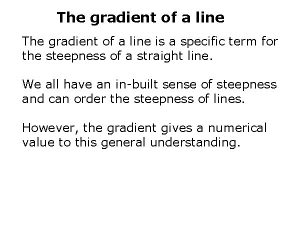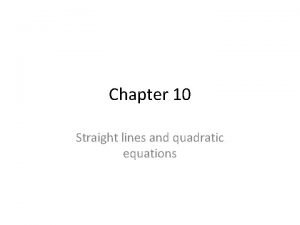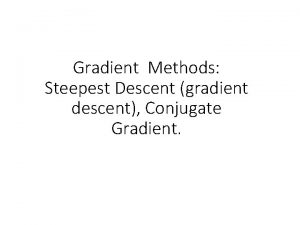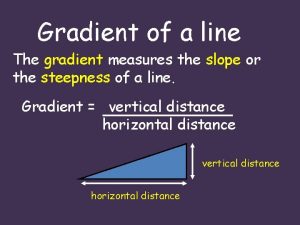The gradient of a line is a specific











- Slides: 11

The gradient of a line is a specific term for the steepness of a straight line. We all have an in-built sense of steepness and can order the steepness of lines. However, the gradient gives a numerical value to this general understanding.

To calculate the gradient of a line we count the vertical distance that line increases and horizontal distance that the line and then use the following calculation. gradient = vertical change horizontal change

B D 3 6 C A 6 4 E Gradient AB = F 1 7 vertical = 6 = 1. 5 4 horizontal

A B C

Note: A negative gradient means that the line is travelling downhill or a decline.

Calculating the gradient from co-ordinates It is possible to calculate the gradient of a line just by knowing two co-ordinates that the line passes through. This can be achieved in two ways: 1. Draw the co-ordinates on a grid and use the previous method. Gradient = Change in y Change in x = Vertical horizontal

2. Using a formula that has been specifically generated for the calculation. Let a line pass through two co-ordinates (X 1, Y 1) and (X 2, Y 2). Gradient = Change in y Change in x = Y 2 - Y 1 X 2 - X 1

(X 2, Y 2) Y 2 - Y 1 (X 1, Y 1) X 2 - X 1

Example: Calculate the gradient of the line between the following pairs of co-ordinates. 1. (1, 2) and (5, 18) m = Y 2 - Y 1 X 2 - X 1 = 18 - 2 = 16 = 4 5 -1 4 Note: The gradient of a line is more usually given the label (m).

2. m = 3. m = (7, 5) and (3, 13) Y 2 - Y 1 X 2 - X 1 = 13 - 5 = 3 -7 8 = -4 -2 (4, -2) and (-2, -5) Y 2 - Y 1 X 2 - X 1 = -5 – (-2) = - 3 = -6 -2 -4 ½

3. (4, -2) and (-2, -5) x y x (4, -2) 3 x (-2, -5) 6





















